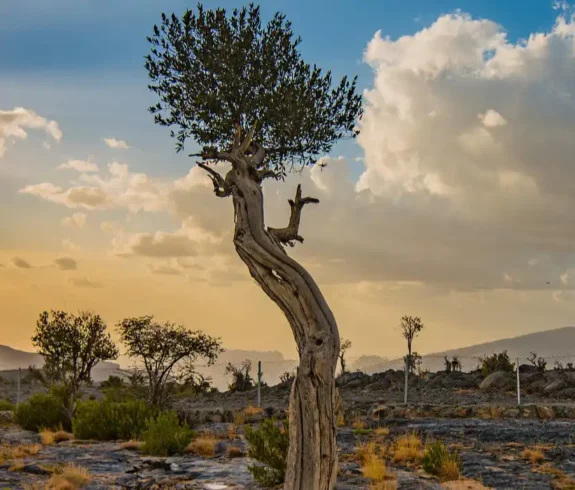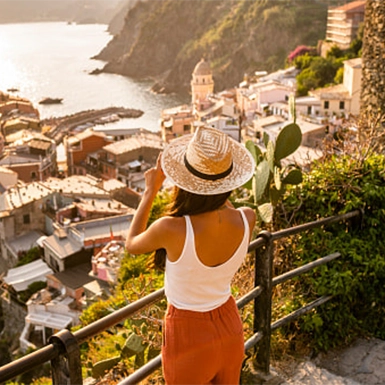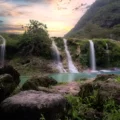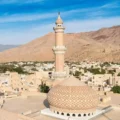Jebel Shams, the majestic mountain in the Al Hajar range, is the highest point in Oman. This high-altitude mountain offers astonishing sunrise views and attracts thrill-seeking travelers and nature lovers. Standing at 3,009 meters, people often call Jebel Shams the Mountain of the Sun because it captures the first ray of light and showcases the sunlight at its fullest.
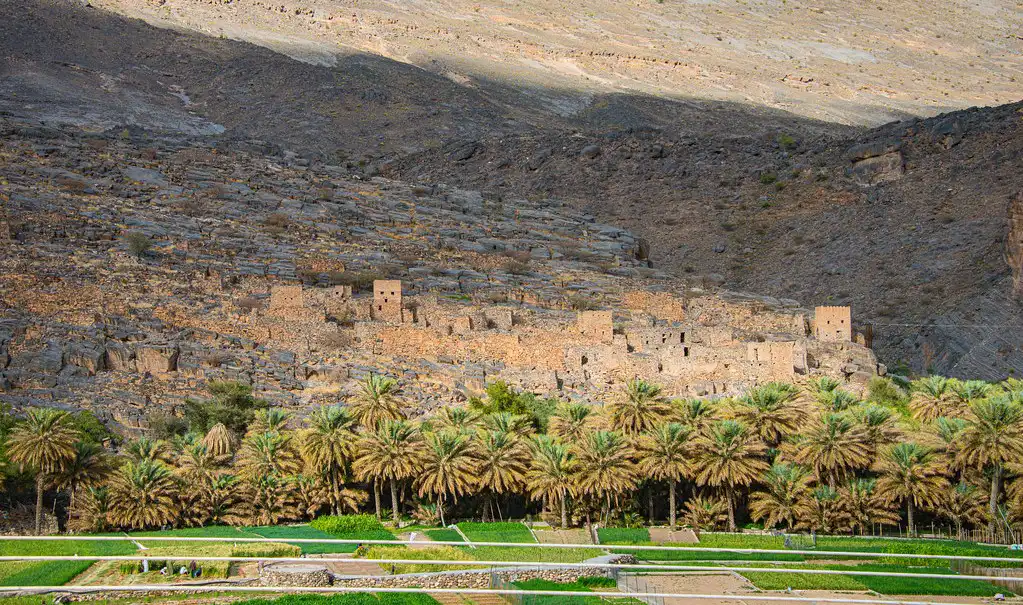
Jebel Shams lies close to the village of Al Hamra and serves as a focal point for trekkers, camera enthusiasts, and people who love the outdoors. In addition to picturesque scenery depicting extreme natural beauty, the region is famous for the sights that Oman’s topography offers its visitors. Be it a quest for an active mountain holiday or an idyllic mountain retreat, this mountain is brimming with many experiences suitable for each kind of visitor.
Key Features
- Location: Jebel Shams sits in northern Oman’s Al Hajar Mountain system. It is near Al Hamra, making it convenient for travelers who want to venture into the region. The mountain lies in a picturesque snow-capped mountain range extending over the northern parts of Oman, which offers excellent views of gorges and flat plains.
- Height: As the highest peak in Oman, this mountain is approximately 3009 meters 9872 feet above sea level. This height implies that this place should be on the bucket list of any traveler who wants to visit the country’s highest point. Tourists often go to the summit to view the beauty of the scenery on the rising landscape of the arid variance below, juxtaposed with the craggy cliffs of the Al Hajar mountains opposite.
- Name Meaning and Significance: “Jebel Shams” translates to “Mountain of the Sun,” reflecting the mountain’s unique position as one of the best spots in Oman to view the sunrise. Its eastern-facing slopes catch the first light of day, illuminating the dramatic scenery and creating an awe-inspiring spectacle for visitors who trek in the early morning. This unique feature has contributed to its popularity, with many travelers seeking to witness the sun rising over Oman’s vast, rocky landscape.
The Grand Canyon of Arabia
Jebel Shams, also called “Mountain of the Sun,” is breathtaking in Oman. Located near the spectacular Wadi Ghul, often called the Grand Canyon of Arabia, this mountain treats visitors to sweeping views of towering cliffs, rugged terrain, and deep gorges. This mountain is a must-visit destination for witnessing the grandeur of Oman’s natural beauty.
Jebel Shams and Wadi Ghul: The Grand Canyon of Arabia
Jebel Shams sits next to Wadi Ghul, a breathtaking canyon that people call the Grand Canyon of Arabia. Stretching across the Al Hajar Mountain range, this massive canyon presents some of the most awe-inspiring scenery in the Middle East. The impressive height of this mountain, combined with the sheer depth of Wadi Ghul, offers visitors a truly unforgettable experience.
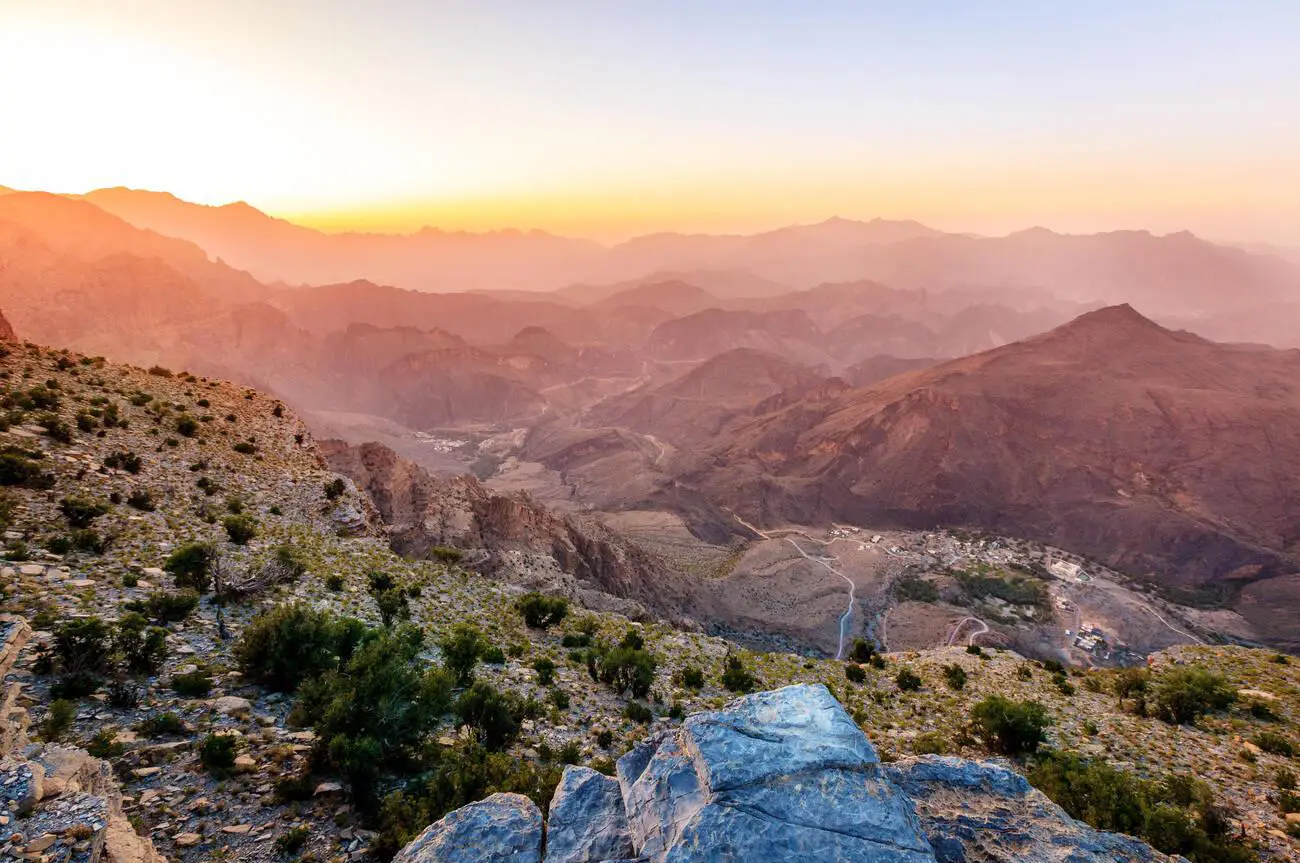
The cliffs of Wadi Ghul create dramatic views, making it clear why this canyon stands out as one of the region’s most remarkable natural attractions. Travelers visiting this mountain can enjoy these incredible vistas by trekking along the mountain’s ridges or stopping at scenic viewpoints. The deep gorges that cut through the landscape enhance the area’s beauty, making it a perfect spot for hikers, photographers, and nature lovers.
Scenic Viewpoints
- The Balcony Walk: The Balcony Walk stands out as one of the most popular hikes at Jebel Shams, offering unbeatable views of the canyon below. This trail leads along the mountain’s edge, giving visitors a front-row seat to the incredible scenery of the Grand Canyon of Arabia. The hike is easy to navigate and accessible to many, making it a must-see for anyone visiting this mountain.
- Viewpoints Along the Ridge: Several viewpoints dot the ridges of this mountain, providing visitors with perfect spots to admire the vastness of Wadi Ghul. These lookout points allow you to view the dramatic cliffs and deep gorges from different angles. Each viewpoint reveals a different aspect of this natural wonder, giving visitors a full appreciation of its scale and beauty.
Activities and Adventures
Jebel Shams, Oman’s highest peak, known as the “Mountain of the Sun,” offers more than breathtaking views. It’s a haven for adventurers and nature lovers, providing a range of activities from trekking and rock climbing to camping and stargazing. Here’s how you can make the most of your visit to this mountain.
1. Trekking and Hiking
Jebel Shams is a trekker’s paradise with routes varying in difficulty and scenery. Here’s what you need to know about the most popular trekking paths:
- Balcony Walk: The Balcony Walk is a famous trek along the canyon’s rim, offering spectacular views. This relatively accessible trail is perfect for those looking to enjoy the natural beauty without a strenuous climb.
- Summit Trek: For the more experienced hikers, the Summit Trek presents a challenging tour to the top of this mountain. This trek requires good physical condition and proper gear, as it takes you to the highest point in Oman, promising unparalleled vistas.
- Wadi Ghul Hikes: The trails around Wadi Ghul are ideal for shorter, more casual hikes. They are accessible and less demanding, perfect for a family outing or a quick nature escape.
2. Rock Climbing
Adventure enthusiasts will find this mountain a thrilling destination for rock climbing. The rugged terrain and sheer cliffs provide numerous routes for climbers of all skill levels. Check local guides and tour operators for the best spots and safety advice.
3. Camping Under the Stars
Camping at Jebel Shams offers an unforgettable experience. The area provides several popular camping sites to set up a tent and enjoy the serene desert night sky. The best times for camping are the cooler months, from October to April, when the weather is pleasant. Bring all the necessary equipment and follow local rules to have a safe and fun time outdoors.
4. Star Gazing
This mountain is ideal for stargazing thanks to its high altitude and remote location. The minimal light pollution allows for precise, starry skies that fascinate amateur astronomers and casual viewers alike. Bring a telescope or relax and enjoy the cosmic show.
Climate and Best Time to Visit
Jebel Shams boasts a unique climate that sets it apart from the rest of Oman. Understanding the seasonal changes and choosing the right time to visit can significantly enhance your experience.
Seasonal Changes
- Cooler Temperatures: This mountain enjoys cooler temperatures than Oman’s coastal and desert regions. This cooler climate makes it an attractive summer escape for locals and tourists seeking relief from the heat.
- Distinct Seasons: The mountain experiences four distinct seasons—spring, summer, autumn, and winter. Each season brings its charm, from blooming wildflowers in spring to crisp, clear nights in winter.
- Rainfall: This mountain receives occasional rainfall, primarily during the winter months. These rains nourish the unique flora and maintain the region’s lush greenery.
Best Time for Visitors
- Spring (March to May): Spring is one of the best times to visit this mountain. The pleasant weather makes it ideal for trekking and outdoor activities. The landscape comes alive with wildflowers, adding vibrant colors to the scenery.
- Autumn (September to November): Autumn offers another ideal window for visiting. The temperatures are pleasant, and the skies are often straightforward, providing excellent conditions for hiking and sightseeing.
- Summer (June to August): While summer is hot in many parts of Oman, this mountain remains cool. Though occasional rains may occur, it’s a popular time for those looking to escape the heat.
- Winter (December to February): Winter brings colder temperatures, sometimes dropping to freezing at night. While the weather can be chilly, it’s a great time for stargazing and enjoying the serene mountain environment.
Wildlife and Flora
Jebel Shams is known for its stunning landscapes, diverse wildlife, and unique plant life. Exploring the mountain offers a chance to encounter various species that thrive in this high-altitude environment.
Local Fauna
- Mountain Goats: These agile creatures commonly navigate this mountain’s cliffs and rocky terrain. Their sure-footedness makes them fascinating sights for visitors.
- Arabian Leopards: Although rare and elusive, Arabian leopards inhabit the region. Spotting one is a rare treat, as they are highly elusive and primarily nocturnal.
- Birds: The mountain is a haven for bird watchers. You can spot majestic eagles soaring above the cliffs and vultures circling in the sky. Other birds, such as falcons and hawks, also call Jebel Shams home.
- Small Mammals: Various small mammals contribute to this mountain-rich biodiversity, including hedgehogs and foxes.
Flora
- Juniper Trees: The high-altitude environment supports hardy juniper trees that withstand the harsh climate. These trees are vital to the survival of local wildlife, providing them with food and shelter.
- Wildflowers: During spring and autumn, this mountain blooms with various wildflowers. These vibrant plants add splashes of color to the rugged landscape, creating picturesque views.
- Shrubs and Grasses: Resilient shrubs and grasses cover the mountain’s terrain, thriving in the rocky soil. These plants are crucial in preventing soil erosion and maintaining the ecosystem.
- Medicinal Plants: Some areas of this mountain are home to medicinal plants that local communities use for traditional remedies. These plants highlight the mountain’s importance to both nature and culture.
Cultural Significance
Jebel Shams is often associated with breathtaking views; however, it is not only that, but it is also of great cultural importance. The inhabitants of the nearby villages provide visitors with a deeper understanding of Omani lifestyles. Visiting the other towns and crafts helps people appreciate Oman’s exotic culture.
Traditional Omani Villages
Several traditional villages near this mountain give visitors a glimpse into the heart of Omani culture, where local customs and hospitality are part of everyday life.
- Misfat Al Abriyeen: This ancient village near this mountain showcases Oman’s terraced gardens and historic mud-brick homes.
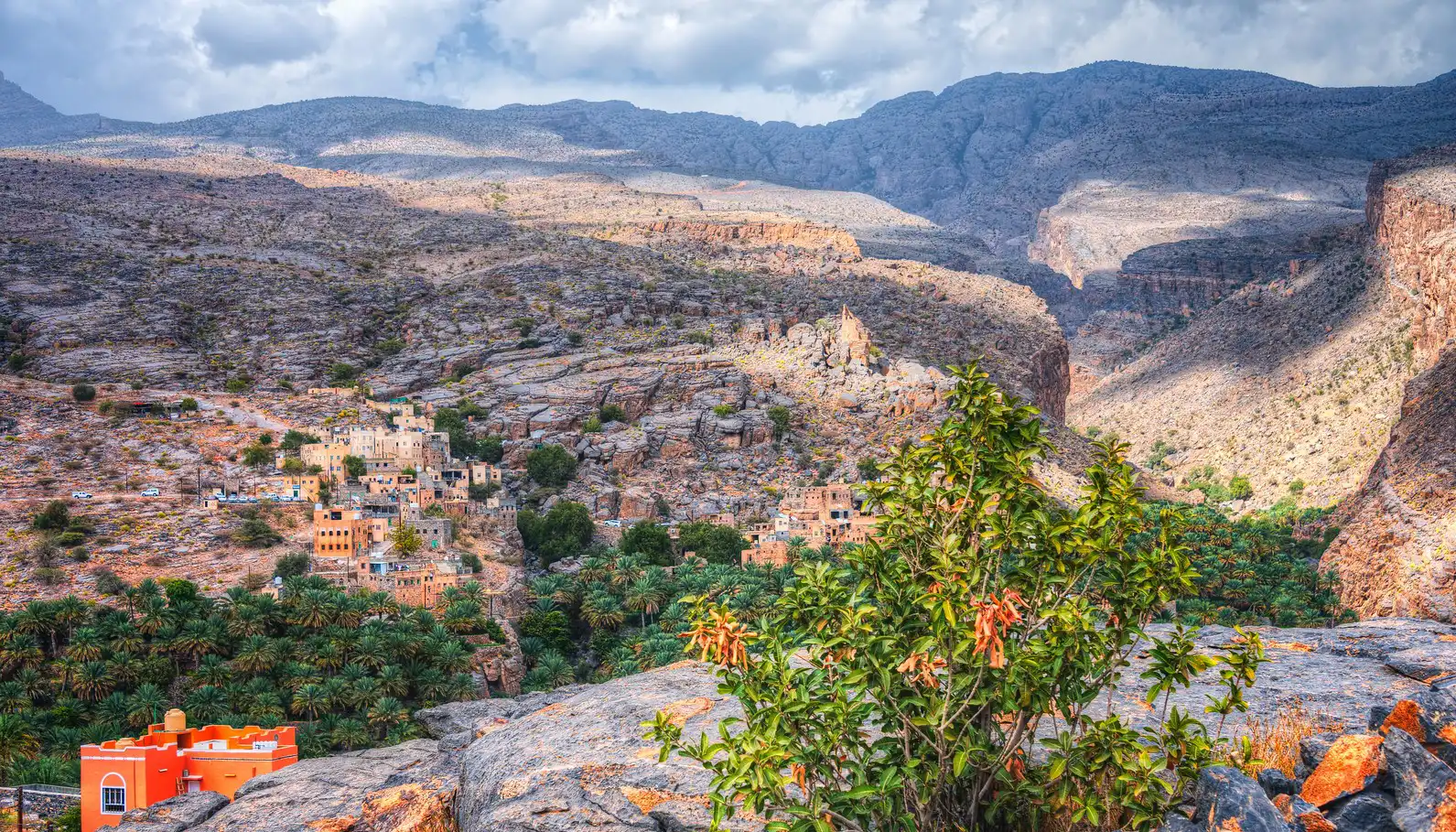
Strolling through its narrow streets and stone pathways takes you back in time. You can witness how villagers have preserved centuries-old farming techniques, giving you an authentic taste of rural life in Oman.
- Al Hamra: Located near this mountain, Al Hamra is one of Oman’s oldest and best-preserved villages. Its traditional homes and ancient falaj irrigation system date back over 400 years.
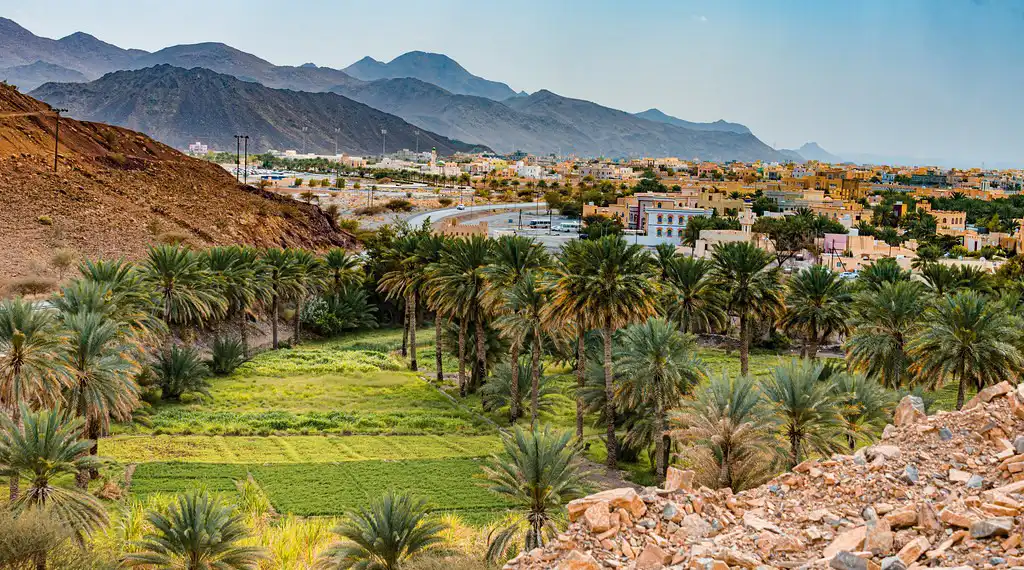
Walking through this village lets you see how locals have seamlessly blended their natural surroundings with their way of life, keeping age-old traditions alive. Many visitors are welcomed with Omani coffee and dates, making their visit even more special.
Local Handicrafts
The villages surrounding this mountain are home to artisans who create beautiful handcrafted items, keeping traditional Omani crafts alive. Visitors can purchase these items, helping to support local craftsmanship and take a piece of Omani culture back home.
- Rugs and Textiles: Local women use traditional looms to weave intricate rugs and textiles. These handwoven rugs are known for their beautiful designs that reflect Omani heritage. These functional pieces are decorative items that bring Omani culture to life in any home.
- Silverwork and Pottery: The villages near Jebel Shams are also known for their handcrafted silver jewelry and pottery. The intricate designs on these items showcase skills passed down through generations. Visitors can purchase these unique items directly from the artisans, making for a special souvenir.
- Basketry and Weaving: Traditional basket weaving is another craft that thrives in the villages around this mountain. Artisans use palm fronds to create durable and beautifully designed baskets, highlighting their creativity and craftsmanship.
Accommodations and Lodging
Jebel Shams, famous for its spectacular scenery and outdoor activities, offers visitors various accommodations. Whether you’re looking for a luxurious resort or a simple guesthouse, there are plenty of options for every type of traveler. Here are some top recommendations for staying near Jebel Shams.
Resorts and Guesthouses
Several resorts and guesthouses around this mountain provide comfortable lodging with breathtaking views of the surrounding canyons and mountains. These are some of the most popular choices:
- Jebel Shams Resort: Located near the peak, Jebel Shams Resort boasts incredible views of the mountain and the Grand Canyon of Arabia. The resort offers cozy rooms, family suites, and traditional Bedouin-style tents for those seeking a more authentic stay. Enjoy the stunning scenery and cool mountain air while relaxing in our outdoor seating areas.
- The View Oman: Situated in Al Hamra, The View Oman is a luxurious eco-lodge that provides panoramic views of the mountains and valleys. The lodge combines comfort with sustainability, featuring an infinity pool and spacious terraces where guests can enjoy nature without sacrificing modern amenities.
- Sama Heights Resort: Nestled near Jebel Shams, Sama Heights Resort offers a peaceful retreat for nature lovers. Accommodations range from standard rooms to tents, all with views of the dramatic landscapes. The resort’s serene environment is ideal for unwinding after a day of exploring the area.
Local Amenities for Travelers
Due to this mountain’s remote location, its visitors must plan, especially regarding food and basic amenities. While many accommodations provide necessary facilities, preparing in advance ensures a comfortable stay.
Food Options
- On-Site Dining: Many resorts and guesthouses, including Jebel Shams Resort, have on-site dining that serves traditional Omani dishes. This option allows guests to enjoy local cuisine without leaving the area, making mealtime convenient and enjoyable.
- Self-Catering: Some accommodations, like Jebel Shams Resort and Sama Heights, offer self-catering facilities for those who prefer to prepare meals. It is particularly useful for visitors planning extended stays or those with specific dietary preferences.
- Nearby Restaurants: While the region is remote, a few local restaurants in Al Hamra serve authentic Omani food. Though options may be limited, these eateries offer a chance to experience the rich flavors of traditional Omani cuisine.
Special Arrangements for Remote Wilderness Experiences
- Pack Essentials: Because Jebel Shams is remote, if you plan to explore the wilderness for a long time, make sure to bring plenty of food, water, and supplies. Being well-prepared ensures a smoother experience in this remote environment.
- Outdoor Gear: Most accommodations can help organize outdoor activities such as hiking and stargazing. While some gear may be available for rent, it’s a good idea to bring your hiking boots and any personal equipment to stay comfortable and safe.
- Camping: Jebel Shams Resort and Sama Heights offer tent accommodations for travelers who enjoy camping, allowing for a more immersive outdoor experience. However, check the weather forecast before camp, as temperatures can drop significantly at night.
Navigating to Jebel Shams: A Travel Guide
Jebel Shams, Oman’s highest peak, mesmerizes visitors with its stunning vistas and opportunities for adventure. If you’re planning a trip, here’s your comprehensive guide to reaching this spectacular destination and insights on navigating the roads.
Getting to Jebel Shams from Major Cities
Traveling to this mountain involves a straightforward route from major cities like Muscat or Nizwa, but it does require some planning, particularly if you are driving.
- From Muscat to Jebel Shams: Jebel Shams is roughly 240 kilometers, or about 150 miles, away from Muscat, the capital city. Typically, the drive takes between three and four hours. Start your tour on Route 15 towards Nizwa, proceed to Al Hamra, a quaint town near this mountain, and then follow the signage directly to this mountain. This route offers scenic views that make the driving experience particularly pleasant.
- From Nizwa to Jebel Shams: The drive to Jebel Shams usually takes 1.5 to 2 hours, starting from Nizwa, which is closer at about 80 kilometers (50 miles). The route passes through Al Hamra before ascending towards this mountain, with clear markers guiding you to your destination.
Road Conditions and Vehicle Recommendations
The condition of the roads leading to this mountain varies, becoming more challenging as you approach the mountain.
- Highway Conditions: The roads from Muscat or Nizwa to Al Hamra are paved and well-maintained, providing a smooth driving experience. Regular vehicles suit this tour segment, as the roads are clear and pose minimal difficulties.
- Mountain Roads: Beyond Al Hamra, the road starts to climb steeply into the mountains. Initially paved, it soon transitions to unpaved sections filled with loose gravel and rocks as you near this mountain.
- Requirement for 4WD: Due to steep gradients and rough road patches, the final leg of the drive to Jebel Shams requires a 4WD vehicle. For those who do not own a 4WD, consider renting one in Muscat or Nizwa or book a guided tour with local operators who provide appropriate transportation.
- Driving Precautions: Exercise caution while driving on the mountain roads to Jebel Shams. Take it slow and avoid driving at night, as reduced visibility can make roads dangerous. Check the weather forecast before you head out, especially in the rainy season, to prevent any slippery surprises on the road.
Safety Tips
Due to its breathtaking views and adventure opportunities, Jebel Shams is a favorite among hikers and nature lovers. To ensure a safe and enjoyable time on the mountain, here are some essential safety tips to remember while exploring this mountain.
Trekking Precautions
Hiking in Jebel Shams is exciting. However, it is important to take appropriate precautions to ensure safety.
- Bring Plenty of Water: Staying hydrated is essential, especially at high altitudes. Always carry enough water to last the entire hike, as dehydration can happen quickly in this environment.
- Wear the Right Gear: Sturdy hiking boots with good grip and ankle support are necessary for tackling this mountain rocky terrain. Also, remember to pack a hat and sunscreen to protect yourself from the sun.
- Know the Altitude Challenges: At over 3,000 meters, this mountain altitude can affect some hikers. Always be aware of signs of altitude sickness, such as headaches, dizziness, or fatigue. If you feel unwell, it is important to descend to a lower altitude immediately.
- Stick to Marked Trails: Jebel Shams has several marked hiking trails, including the popular terraced walking route. Use these trails to avoid getting lost and ensure a safe hiking experience.
Weather warnings
Weather conditions can change quickly in Jebel Shams, so be prepared for changes in temperature and visibility.
- Be prepared for rapid changes: Jebel Shams’ high altitude means the weather can change quickly, even within a day. Sudden changes in wind or cloud cover can affect visibility and temperatures. So be prepared for these changes.
- Pack for Temperature Drops: Even in warmer months, the temperature at this mountain can fall sharply in the late afternoon or evening. Always bring a warm jacket or sweater, especially if you plan to camp or stay overnight.
- Check the Forecast: Before heading to this mountain, always check the weather forecast to prepare for rain, storms, or extreme temperature changes. The estimates can help you bring the right gear and stay safe while hiking.
Photography and Views
Jebel Shams, Oman’s tallest peak, is a paradise for landscape photographers and nature lovers. Its towering cliffs, expansive canyons, and panoramic views create the perfect setting for capturing breathtaking shots. Whether you’re an experienced photographer or want to take stunning photos of the landscape, this mountain offers some of the finest photography spots in Oman.
Top Photography Spots
The Balcony Walk: One of this mountain’s most famous photography locations is the Balcony Walk. This trail follows the mountain’s edge, revealing incredible views of Wadi Ghul, known as the Grand Canyon of Arabia. The rugged cliffs and deep valleys make this an ideal spot to capture the vastness of the landscape. To get the best shots, visit during the early morning or late afternoon when soft lighting enhances the natural textures of the rock.
- Sunrise and Sunset Views: Jebel Shams offers spectacular sunrise and sunset views. At sunrise, the eastern slopes provide the perfect vantage point to capture the first light as it illuminates the rugged terrain. Sunset is just as stunning, with the warm glow casting long shadows over the canyon. The shifting colors of the sky and landscape create a dramatic backdrop, ideal for photography.
- Summit Viewpoints: Trekking to the summit of this mountain rewards you with a breathtaking 360-degree view of the surrounding region. At more than 3,000 meters, the summit offers a bird’s-eye perspective of Oman’s mountain ranges and deep canyons. The wide-open views at the top allow endless opportunities to capture panoramic shots of the stunning landscape below.
- Wadi Ghul – The Grand Canyon of Arabia: Wadi Ghul, often known as the Grand Canyon of Arabia, is another amazing photography location near this mountain. The cliffs and sheer drop-offs create dramatic scenery that any photographer will love. As the light shifts throughout the day, the rock formations and colors in the canyon change, making this a prime location for morning and afternoon photography.
Why Jebel Shams is a Landscape Photographer’s Paradise
- Dramatic Landscapes: Jebel Shams’s rugged mountains, deep canyons, and high cliffs make it every photographer’s way toward paradise. The stunning landscapes provide ample chances to experience the true beauty of the country, Oman’s nature.
- Unique Lighting Conditions: Jebel Shams boasts wonderful light effects and is one of the most impressive outdoor places, especially during the extreme golden hours at sunrise and sunset. By doing so, the alternating blisses at the surface of the rocky outer parts of the region offer a place conducive to taking wonderful pictures of still motion now and then.
- Variety of Perspectives: Jebel Shams provides a range of perspectives, from the sweeping views at the summit to the intricate details of the rock formations along the Balcony Walk. Whether capturing wide-angle landscapes or zooming in on the finer details, Jebel Shams gives photographers endless possibilities.
